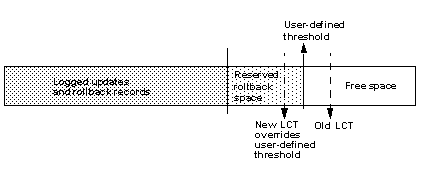Because rollback records occupy extra space in the transaction log, there is less free space after the user-defined threshold for completing a dump than in versions of Adaptive Server that do not use rollback records (See Figure 31-4). However, the loss of space for a dump because of the increased last-chance threshold is likely to be more than compensated for by the space reserved for rollback records for open transactions.
Upgrading to version that uses rollback records affects user-defined thresholds similarly to the way it effects last-chance thresholds. Figure 31-5 illustrates the effect of upgrading to an Adaptive Server using rollback records on a user-defined threshold:
Figure 31-5: Effect of upgrading on user-defined thresholds

A user-defined threshold such as the one in Figure 31-5 is often used to initiate a dump transaction. The threshold is set so there is enough room to complete the dump before the last-chance threshold is reached and all open transactions in the log are suspended.
In databases that use mixed log and data, the last-chance threshold moves dynamically, and its value can be automatically configured to be less than the user-defined threshold. If this happens, the user-defined threshold is disabled, and the last chance threshold fires before the user-defined threshold is reached, as shown in Figure 31-6:
Figure 31-6: LCT firing before user-defined threshold

The user-defined threshold is re-enabled if the value of last-chance threshold is configured to be greater than the user-defined threshold (for example, if the last chance threshold is reconfigured for the value of “Old LCT” in Figure 31-6).
In databases with a separate log segment, the log has a dedicated amount of space and the last-chance threshold is static. The user-defined threshold is not affected by the last-chance threshold.